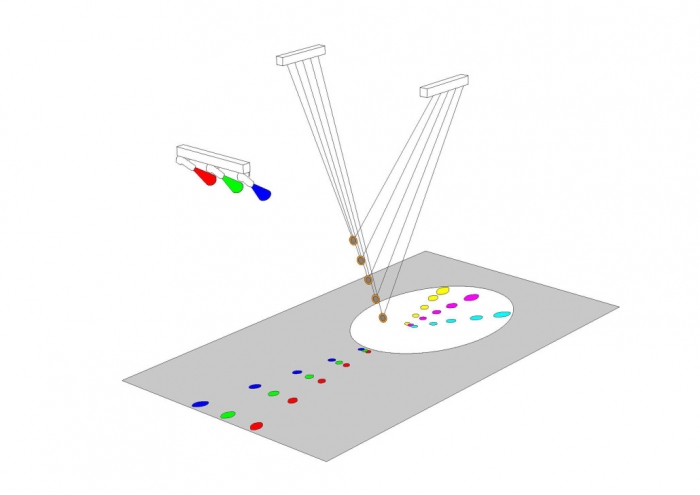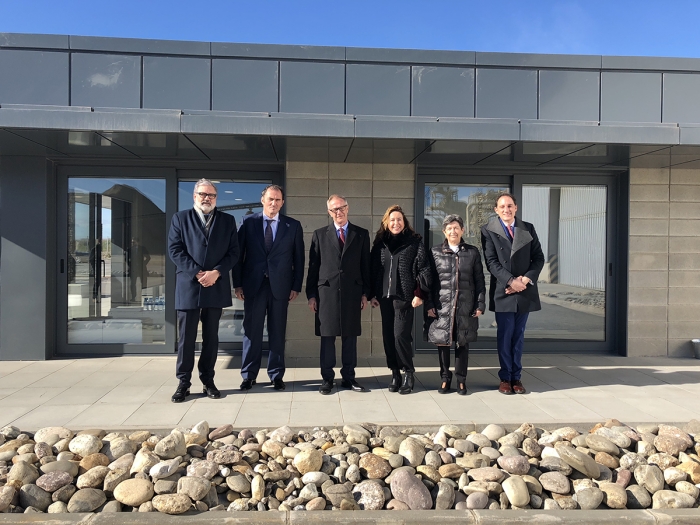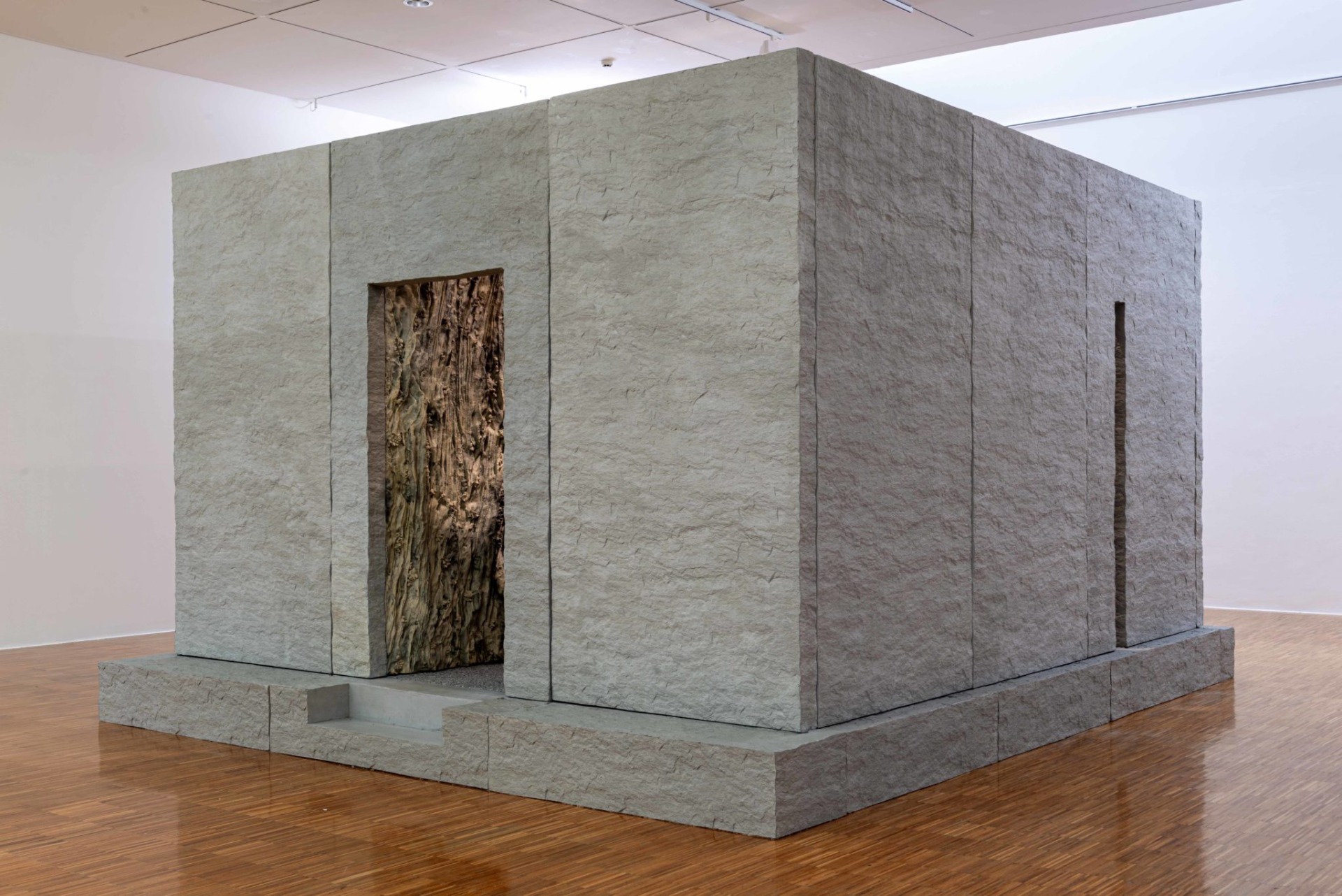From October 30, the PLANTA project, sponsored by Sorigué and the Sorigué Foundation in Lleida, Spain, will host the installation Double Bind, by artist Juan Muñoz (1953-2001).
This extraordinary large-scale sculptural installation, is considered the master work of its internationally renowned creator, and was created in 2001 for Tate Modern Turbine Hall.
This monumental work will be exhibited for the first time in Spain in a unique setting: the PLANTA project, a place where contemporary artistic creation and business innovation meet and interact, offering artistic and architectural possibilities not found anywhere else on earth.
A documentation center has been set up near the work, offering information about the piece and the artist by means of drawings and notes made by Juan Muñoz himself, as well as documentary images and videos, catalogs, and a selection of sound clips.
With this installation, PLANTA opens its doors to the public for the first time, after displaying its architectural design at the Chicago Biennial in September. In the coming months, the Sorigué project and its foundation will host specific sites featuring the work of great artists such as William Kentridge, Bill Viola, Wim Wenders, and others.
The work considered the pinnacle of artist Juan Muñoz’s (Madrid 1953-Ibiza 2001) career will be exhibited for the first time in Spain at PLANTA, the project sponsored by Sorigué and the Sorigué Foundation, which will host the piece for the next 5 years in a unique space covering more than 2,000 square meters, which has been transformed specifically to house this work.
Double Bind was created in the year 2001, as a project conceived specifically for the Tate Modern Turbine Hall as part of the “Unilever Series”, where it was curated by James Lingwood and Susan May.
Double Bind is a multi-level installation, segmented to create different layers of experience. Vast but not monumental, it creates an intimate experiential space, according to James Lingwood.
This complex work brings together the characteristic elements of the work of Juan Muñoz and establishes a dialog with space, perspective, horizontality and verticality, illusion, the visible and the invisible. Because of the complexity of the installation and the repertoire of elements that it brings together and the space that it builds, Double Bind has come to be regarded as a masterwork of our time.
A few months after the presentation of Double Bind at Tate Modern, Juan Muñoz died at the age of 48. The work was dismantled at Tate in March of 2002, having achieved the status of his final great work.
In 2015, the Hangar Bicocca space in Milan presented a retrospective, curated by Vicente Todolí, covering the Muñoz’s career and including for the first time, among other works, the Double Bind installation.
NOW, IN 2017, PLANTA PRESENTS DOUBLE BIND, THE FIRST TIME THE WORK HAS BEEN EXHIBITED IN SPAIN, WHERE IT WILL OCCUPY A PAVILION SPECIFICALLY DESIGNED TO HOST ONLY THIS PIECE, IN AN INDUSTRIAL SETTING AND DISRUPTIVE ART SPACE.
The work has been installed in an old industrial building used previously for the manufacture of concrete segments, newly remodeled exclusively for this piece following the lines and dimensions used for the work at Tate Modern. The installation covers an area of 2,000 square meters, more than 100 meters long by 20 meters wide, with a height of 18 meters. The building now includes a ramp more than 40 meters long, leading the spectator to the starting point of the work and accentuating the different levels of experience that it contains.
Next to the building hosting Double Bind, a documentation center has been built with information about the work, which includes catalogs, drawings, photographs, and sound clips of the artist himself, as an aid to understanding the work as well as how it was built and installed at PLANTA.
The area surrounding the installation joins the zone’s natural landscape with the industrial processes that take place at the quarry from which Sorigué extracts materials. The olive groves and heaps of gravel paint a singular landscape, one which also includes unique contemporary art spaces hosting the work of artists such as Anselm Kiefer and Bill Viola, among others.
PLANTA opens its doors to the public through this installation, which exhibits the defining work of Juan Muñoz, a leading figure in contemporary sculpture in recent decades.
ABOUT PLANTA
PLANTA is an innovative project that brings together Sorigué’s interpretation of giving back in the fields of art, science, architecture, landscape, knowledge, and business. The project is located in La Plana del Corb, an active industrial complex in Balaguer (Lleida, Spain) which symbolizes Sorigué’s beginnings as a business group and embodies its values.
PLANTA will include a central building executed by Abalos + Sentkiewicz (AS+) in collaboration with a team of experts associated with the project. The architectural design was exhibited in September of this year at the Chicago Biennial, and can be defined as an experiment in architectural thermodynamics, a thermal machine creating a relationship between the local climate and the materials of which it is constructed, through a meticulous balance of form, material, and flow making possible the creation of a fully autonomous building.
PLANTA also consists of site-specific art spaces without equal anywhere in the world, containing pieces by important international artists, such as the Anselm Kiefer pavilion, which hosts three monumental works by the German artist, and an underground installation by Bill Viola. Currently, work is underway on a large installation by the South African artist William Kentridge, a unique work by German artist Wim Wenders, a large-scale piece by Japanese artist Chiharu Shiota, and a new space created specifically for an exceptional piece by Bill Viola.
The impetus to exhibit Double Bind for the next five years at PLANTA arose from the commitment of the Sorigué Foundation to the art of our time and the artists in its collection: Juan Muñoz is one of the creators included in the foundation’s collection.
ABOUT THE SORIGUÉ FOUNDATION’S CONTEMPORARY ART COLLECTION
For the past 15 years, the Sorigué Foundation has been building one of the most important contemporary art collections in Spain, winner of the Arte y Mecenazgo prize awarded by the “la Caixa” foundation in May of 2015 and the 2017 GAC prize for collecting, awarded by the Gremio de Galerías de Arte (art galleries’ guild) of Catalonia with the collaboration of the Asociación Art Barcelona, in 2017.
Consisting of more than 450 works by Spanish and international artists, the Sorigué Foundation collection is organized around artistic values rather than specific styles, and focuses on the most sensitive and emotional aspects of contemporary art. As a result, the works of internationally renowned artists stand next to the works of virtual unknowns, as this is an open collection that establishes myriad connections between different artistic languages and the environment.
The institution maintains an active lending policy with other Spanish and international entities. The collection has participated in exhibitions produced by the Thyssen-Bornemisza Museum in Madrid, the Museum of Modern Art in New York (MoMA), the Museum of Fine Arts in Bilbao, the Albertina Museum in Vienna, The Santa Mónica Art Museum of California, the Tate Gallery in Liverpool, the Andalusian Center for Contemporary Art (Centro Andaluz de Arte Contemporáneo – CAAC) in Seville, Arts Santa Mónica in Barcelona, the Palazzo Fortuny in Venice, and the Boston Museum of Fine Arts, among others.
One of the collection’s areas of focus, along with moving images, drawing and painting, is contemporary sculpture. The collection includes major contributions by some of the most outstanding artists in this field, including works by artists such as Doris Salcedo, George Segal, Anthony Gomley, Anish Kapoor, Cristina Iglesias, Tonny Cragg, Eric Fischl, Kiki Smith and, of course, Juan Muñoz, who is represented in the collection by his work “Four Piggybacks with knives”, a sculptural piece composed of eight bronze human figures. The work was completed in 2001, the same year in which Double Bind was presented at Tate Modern.
ABOUT DOUBLE BIND
Double Bind was created in the year 2001, as a project specifically conceived for the Tate Modern Turbine Hall as part of the “Unilever Series”, where it was curated by James Lingwood and Susan May. This installation was the second proposed in what was known at the time as the “Unilever Series”, whose objective is to invite contemporary artists to respond to the colossal entry space of the Tate Modern museum, designed by architects Herzog & De Meuron.
The first to participate in this program was the French-American artist Louise Bourgeois, followed by Juan Muñoz. This space has been occupied by some of the world’s most important artists, who have established new paradigms to express the relationship between art and space, including Doris Salcedo, Tacita Dean and Anish Kapoor.
In 2000, Tate Modern invited Muñoz to create a work for this space. This was the same year in which he was awarded the National Prize for Visual Arts by the Spanish Government. To date, he is the only Spanish artist to have participated in the Tate project. For Juan Muñoz, Double Bind involved a return to the city that had played an important role in his career, since London is where he was trained as an artist in the 1970s. A few months after the presentation of Double Bind at Tate Modern, Juan Muñoz died at the age of 48. The work was dismantled a year later, making Double Bind his final masterwork.
The piece has an upper horizontal level, from which the participant observes an optical landscape that cannot be traversed. Two empty elevators pass through this level, rise to the ceiling of the hall and descend to the lower level, marking the depth of the space while incorporating movement. On the lower level, which is darkened as if it were a garage, the spectators are free to walk about and observe the intermediate space above, in which scenes are represented in inner courtyards or shafts built between columns. These spaces contain twenty human figures, architectural elements such as windows, doors, blinds, and air conditioning units. The components of the work are made of polyester resin, fiberglass, naturally pigmented cloth, and wood.
ABOUT JUAN MUÑOZ
Juan Muñoz is best known for his sculptural works in which the human figure is placed within elaborate or complex architectural environments, alienating settings, and fictitious worlds inhabited by a variety of characters, giving rise to endless possible narratives.
He was born in Madrid in 1953. He was tutored by art critic Santiago Amón, who played a major role in his education. In 1970, he moved to London where he studied at the Central School of Art and Design and the Croydon School of Art. In 1981 he received a Fulbright fellowship, allowing him to study at the Pratt Graphic Center and take a position as artist in residence at the PS1 Contemporary Art Center in New York.
After his stay in the United States, he moved to Madrid. In 1983, after curating two exhibitions, he abandoned curating to focus on sculpting, but he continued writing texts and collaborating with other disciplines. He held his first exhibition in 1984 and, during the decades that followed, created one of the most exceptional art careers of the last third of the 20th century.
Juan Muñoz explored the relationship between the human figure and the exhibition space. He explored new ways to distort space, using daring perspectives and variations of scale, not only to commit the spectator at the perceptual and sensory level, but also, and especially, to create psychological tension in individuals interacting with his work.
He created a new paradigm for artistic discourse. As the critic and historian Jan Avgikos has stated, he created a paradigm of expression without being expressionist, “blurring the lines between the past and the present”. In addition to his sculptural work, he also drew, created installations and sound pieces, and collaborated with actors, musicians and filmmakers, thus taking on the role of an authentic contemporary humanist.
As stated by Manuel Borja Villel, director of the Reina Sofía Museum, “in every one of these productions, we find points of connection within a coherent but runaway universe which, frequently operating from a standpoint of absence, always allude to something beyond their own disciplinary or referential formulation”.
Images (Flickr)



